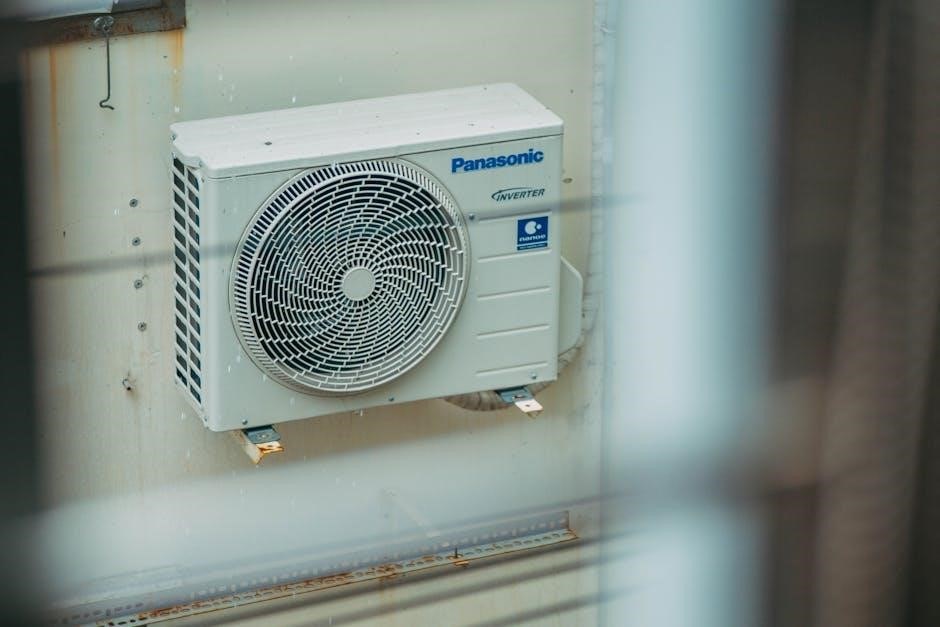Air compressors are indispensable workhorses in various industries, providing power for pneumatic tools. However, unplanned breakdowns can halt operations. This guide empowers you to identify and fix issues swiftly, minimizing downtime and optimizing performance for reliability and productivity.
Importance of Regular Maintenance
Regular maintenance is crucial for ensuring the longevity and efficiency of air compressors. Neglecting routine checks can lead to premature wear, costly repairs, and unexpected downtime. By monitoring oil levels, cleaning filters, and inspecting hoses, you can prevent issues like overheating and pressure drops. Consistent upkeep also helps maintain optimal performance, reducing the risk of breakdowns and ensuring reliable operation. A well-maintained compressor not only saves time but also minimizes operational costs, making it a vital practice for both industrial and home use. Schedule regular servicing to keep your air compressor running smoothly and efficiently.
Common Causes of Air Compressor Failures
Air compressor failures often stem from overheating, inadequate lubrication, and air leaks. Overheating can damage components and lead to premature wear. Insufficient oil levels or poor-quality lubricants exacerbate friction, causing mechanical failure. Air leaks in hoses or valves reduce efficiency and pressure, straining the system. Additionally, electrical issues, such as faulty capacitors or wiring, can disrupt operation. Addressing these root causes through timely maintenance and inspections is essential to prevent breakdowns and extend the compressor’s lifespan. Identifying and resolving these common issues ensures smoother operation and reduces downtime significantly.

Understanding Common Air Compressor Problems
Air compressors face issues like air leaks, overheating, and low pressure, which disrupt efficiency. Identifying these problems early ensures timely fixes, maintaining productivity and longevity.
Air Leaks and Their Impact on Performance
Air leaks are a common issue that significantly impacts compressor efficiency. They often occur in hoses, fittings, or gaskets, leading to wasted energy and reduced performance. Identifying leaks early is crucial, as they can increase operating costs and strain the system. Use soapy water or ultrasonic leak detectors to locate leaks. Addressing them promptly with proper seals or replacements ensures optimal airflow and pressure; Regular inspections and maintenance are key to preventing leaks and maintaining compressor reliability.
Overheating Issues and Solutions
Overheating is a leading cause of air compressor failure, often due to excessive duty cycles, poor ventilation, or insufficient cooling. High discharge temperatures can degrade lubricants and damage components. To address this, ensure proper airflow around the unit, clean air filters, and check coolant systems. Reduce operational demands and use thermal overload protections. Regular maintenance, including lubricant checks and replacing worn parts, can prevent overheating. Addressing these issues promptly ensures longevity and reliable performance of your air compressor system.
Low Pressure or Insufficient Air Flow
Low pressure or insufficient air flow in an air compressor can stem from various issues, including air leaks, restricted intake, or clogged filters. Check for leaks in hoses and connections, and ensure the air intake is unobstructed. Clean or replace filters to improve airflow. Additionally, faulty check valves or improperly sized compressors for the task can cause pressure drops. Addressing these issues by sealing leaks, upgrading filters, or adjusting compressor settings can restore optimal performance and ensure reliable operation of pneumatic tools and systems.

Troubleshooting the Motor and Electrical System
Identify issues by checking power supply, fuses, and wiring. Use a multimeter to test circuits and diagnose problems. Common causes include blown fuses, low voltage, or faulty capacitors.
Diagnosing Motor Failure
Motor failure often stems from electrical or mechanical issues. Common signs include the motor not starting, unusual noises, or overheating. Check power supply for voltage drops or blown fuses. Inspect wiring for damage or loose connections. Use a multimeter to test for short circuits or open motor windings. Overheating can result from excessive duty cycles or poor ventilation. Addressing these issues early prevents irreversible damage and ensures reliable operation. Always follow safety guidelines when working with electrical components.
Identifying Electrical Wiring Issues
Electrical wiring problems can prevent your air compressor from functioning properly. Start by checking fuses or circuit breakers to ensure they haven’t tripped or blown. Inspect wires for signs of damage, fraying, or rodent bites. Loose connections at terminals can disrupt power flow. Use a multimeter to test for voltage drops or continuity in circuits. Capacitor issues may also cause the motor to malfunction. Ensure all electrical components meet the compressor’s specifications to avoid overloading. Addressing wiring problems promptly prevents further damage and ensures safe, efficient operation.
Capacitor Problems and Solutions
Capacitor issues are common in air compressors, often causing the motor to fail to start or run. Look for signs like a humming motor or a non-starting compressor. Use a digital multimeter to test the capacitor’s voltage and capacitance. Replace the capacitor if it fails these tests. Ensure the new capacitor matches the original’s specifications. Improper installation can lead to further damage. Always discharge the capacitor before handling to avoid electric shock. Addressing capacitor problems quickly prevents costly repairs and restores compressor functionality.

Compressor Pump and Component Troubleshooting
Troubleshooting the compressor pump involves identifying issues like reed valve failures, piston damage, and crankshaft wear. Regular inspection and timely repairs ensure optimal performance and longevity.
Reed Valve Issues and Repairs
Reed valves play a crucial role in directing airflow within the compressor. A defective reed valve can prevent the compressor from building pressure, leading to poor performance. Common issues include cracks, warping, or improper seating, which allow air to escape during compression. Symptoms include low pressure output and unusual noises. To repair, inspect the valve for damage, clean or replace it if necessary, and ensure proper alignment during reassembly. Regular inspection and maintenance can prevent reed valve failures, ensuring efficient airflow and reliable compressor operation. Addressing these issues promptly avoids further damage to the system.
- Inspect reed valves for cracks or warping.
- Replace damaged valves to restore proper airflow.
- Ensure valves are securely seated to prevent air leaks.
Identifying and Fixing Piston Problems
Pistons are vital components of air compressors, and their failure can lead to significant performance issues. Common piston problems include excessive wear, scoring, or ring damage, often caused by insufficient lubrication or overheating. Symptoms may include reduced compression, loud noises, or oil contamination in the air supply. To address these issues, inspect the piston and cylinder for wear, replace damaged rings, and ensure proper lubrication. Regular maintenance, such as oil checks and cooling system inspections, can prevent piston-related failures, ensuring smooth and efficient compressor operation. Prompt repairs are essential to avoid costly replacements.
- Check piston rings for wear or damage.
- Inspect the cylinder for scoring or excessive wear.
- Ensure adequate lubrication to prevent overheating.
Cylinder and Crankshaft Damage
Cylinder and crankshaft damage are critical issues that can severely impact air compressor performance. Common problems include scoring, excessive wear, or cracks due to overheating, poor lubrication, or contamination. Symptoms may include reduced efficiency, increased oil consumption, or unusual noises. Regular inspections are essential to detect early signs of wear. Addressing these issues promptly involves replacing damaged components, ensuring proper lubrication, and maintaining a clean environment. Neglecting these problems can lead to costly repairs or complete system failure, emphasizing the importance of proactive maintenance and timely interventions.
- Inspect for scoring or cracks in the cylinder.
- Check crankshaft bearings for wear or damage.
- Ensure proper lubrication to prevent overheating.
Pressure System and Valve Troubleshooting
Diagnosing issues in the pressure system and valves is crucial for optimal air compressor performance. Common problems include blockages, incorrect pressure settings, or valve malfunctions. Addressing these promptly prevents further damage and ensures reliable operation.
Pressure Switch Malfunction
A pressure switch malfunction is a common issue in air compressors. It occurs when the switch fails to regulate pressure properly, causing the compressor to either not start or run continuously. This can be due to faulty electrical connections, incorrect pressure settings, or internal component wear. To diagnose, inspect the switch for damage or corrosion. Check the pressure settings against the manufacturer’s specifications. If issues persist, consider replacing the switch. Regular maintenance, such as cleaning and testing the switch, can prevent malfunctions and ensure smooth compressor operation.
Unloader Valve Problems
Unloader valve issues are common in air compressors and can disrupt operation. The unloader valve releases pressure when the compressor stops, ensuring smooth startups. If faulty, it may fail to release pressure, causing the motor to struggle or not start. Symptoms include pressure drop, continuous running, or leaks. Check for blockages, incorrect installation, or worn seals. Clean or replace the valve if necessary. Regular inspection and maintenance can prevent these issues, ensuring efficient compressor performance and longevity. Addressing unloader valve problems promptly avoids further damage and maintains reliable operation.
Check Valve Failures
Check valve failures can significantly impact air compressor performance. These valves prevent air flow reversal, ensuring efficient compression. If a check valve fails, air may leak back into the cylinder, reducing pressure and efficiency. Common issues include worn or damaged seats, debris blockages, or incorrect installation. Symptoms include low pressure, noisy operation, or the compressor not building pressure. Inspect and clean the valve, or replace it if damaged. Regular maintenance, such as checking for blockages and ensuring proper alignment, can prevent check valve failures, maintaining optimal compressor function and reliability over time.

Air Intake and Filter Issues
Restricted air intake and clogged filters are common problems that reduce compressor efficiency. Ensure the intake is clear and filters are clean to maintain optimal performance and airflow.
Restricted Air Intake Solutions
Restricted air intake can significantly reduce your compressor’s efficiency. To address this, ensure the intake vent is free from obstructions and located in a well-ventilated area. Regularly clean or replace air filters to prevent dust buildup. Ensure the intake piping is of adequate size and free from kinks or bends that could restrict airflow. Additionally, check for blockages in the inlet valve and ensure it operates smoothly. By maintaining unobstructed airflow, you can enhance performance, reduce overheating risks, and extend the compressor’s lifespan. Proper airflow is crucial for reliable operation and optimal pressure delivery.
Clogged Air Filters and Their Effects
Clogged air filters are a common issue that can severely impact compressor performance. A blocked filter restricts airflow, leading to reduced pressure, decreased output, and increased energy consumption. Over time, this can cause the motor to overheat, potentially resulting in premature wear or failure. Regular inspection and replacement of air filters are essential to maintain efficiency. Clean or replace filters as recommended by the manufacturer to ensure optimal airflow and prevent downstream problems. Neglecting filter maintenance can lead to costly repairs and downtime, making it a critical component of routine compressor upkeep.

Oil and Lubrication System Troubleshooting
Proper lubrication is crucial for air compressor efficiency. Low oil levels or degraded oil can cause friction, overheating, and premature wear. Regular oil checks and timely replacements ensure smooth operation and prevent costly repairs. Addressing lubrication issues promptly helps maintain compressor longevity and performance.
Low Oil Levels and Lubrication Failure
Low oil levels are a common issue in air compressors, leading to increased friction and overheating. This can cause premature wear on moving parts and eventual system failure. Regular oil checks are essential to ensure proper lubrication. If oil levels are consistently low, inspect for leaks or excessive consumption. Use the recommended lubricant type and viscosity to maintain optimal performance. Neglecting oil maintenance can result in costly repairs, downtime, and reduced compressor lifespan. Always refer to the manufacturer’s guidelines for oil change intervals and capacity requirements.
Oil Leak Identification and Repair
Oil leaks in air compressors can lead to premature wear and operational issues. Inspect hoses, gaskets, and seals for signs of grease or oil residue. Common leak sources include worn piston rings, loose connections, or damaged gaskets. To repair, tighten any loose fittings and replace faulty seals or gaskets. Use a UV dye kit to detect hidden leaks in the system. Addressing leaks promptly prevents oil starvation, which can cause overheating and component failure. Regular maintenance, including oil level checks, helps prevent such issues and ensures smooth compressor operation.

Condensate and Drainage Problems
Condensate buildup and drainage issues can lead to compressor inefficiency and damage. Regularly inspect and clean condensate traps to ensure proper fluid expulsion, preventing blockages and system strain.
Condensate Trap Malfunction
A malfunctioning condensate trap can disrupt proper drainage, leading to moisture buildup and system inefficiency. Common issues include blockages, improper installation, or failure to expel condensate. This can result in pressure drops, reduced airflow, or even compressor damage. Regular inspection and cleaning of the trap are essential to maintain optimal performance. If the trap is faulty, replace it promptly to prevent further complications. Ensure the trap is correctly installed and functioning as designed to avoid condensate-related problems. Addressing this issue early helps maintain compressor efficiency and prevents costly repairs down the line.
Drainage System Blockages
Blockages in the drainage system can severely impact air compressor performance. Accumulated dirt, debris, or frozen condensate often clog drain lines, preventing proper moisture expulsion. This leads to pressure drops, reduced airflow, and potential compressor damage. Regularly inspect and clean drain lines to ensure unobstructed flow. Use appropriate tools to clear blockages and check for damaged or kinked hoses. Proper drainage is crucial for maintaining efficiency and preventing system failures. Addressing blockages promptly helps maintain optimal compressor function and avoids costly repairs. Schedule regular maintenance to keep the drainage system operating smoothly and efficiently.

Noise and Vibration Issues
Air compressors may produce excessive noise or vibrations due to imbalanced parts, loose components, or worn machinery. Regular maintenance and inspection can help mitigate these issues effectively.
Identifying Unusual Noises
Unusual noises from your air compressor can signal underlying issues. A hissing sound may indicate air leaks or faulty valves, while a knocking noise could point to worn piston rings or crankshaft damage. Grinding sounds often suggest bearing wear, and excessive vibration may be caused by imbalanced components. Rattling noises could indicate loose parts or a malfunctioning pulley. Identifying the source of these sounds is crucial for timely repairs. Regular inspection and maintenance can help prevent these issues, ensuring smoother operation and extending the compressor’s lifespan. Always address unusual noises promptly to avoid further damage.
Excessive Vibration Causes
Excessive vibration in air compressors is often caused by misalignment of pulleys or belts, loose mounting hardware, or unbalanced moving parts. Over time, wear and tear can lead to uneven components, exacerbating the issue. Poor piping practices or restricted air intake may also contribute by creating imbalance. Regular inspection of belts, pulleys, and mounts is essential to identify and correct misalignment. Tightening loose components and ensuring proper balance can significantly reduce vibration; Addressing these issues promptly helps prevent further damage to the compressor and surrounding equipment, ensuring smoother and safer operation.

Troubleshooting Charts and Diagnostic Tools
Troubleshooting charts and diagnostic tools simplify issue identification. Flowcharts pinpoint causes of common problems, while tools like multimeters help verify electrical and mechanical malfunctions efficiently.
Using Flowcharts for Quick Diagnosis
Flowcharts are essential tools for rapid troubleshooting, guiding users through logical steps to identify and resolve compressor issues. By visually mapping potential problems, these charts help narrow down causes, from electrical faults to mechanical failures. They often include yes/no questions and straightforward solutions, making complex diagnostics accessible to all skill levels. Regularly updated flowcharts incorporate common issues like pressure drops or motor failures, ensuring relevance. This methodical approach minimizes guesswork, saving time and reducing downtime. Whether you’re a novice or experienced user, flowcharts provide a clear path to restoring your compressor’s operation efficiently.
Digital Multimeter for Electrical Checks
A digital multimeter (DMM) is crucial for diagnosing electrical issues in air compressors. It measures voltage, current, and resistance, helping identify faults like faulty capacitors, defective switches, or wiring issues. By testing circuits and components, users can pinpoint problems efficiently. Many guides emphasize using a DMM to check power supply, motor windings, and capacitor performance. Regular electrical checks prevent unexpected breakdowns and ensure safe operation. With a DMM, troubleshooting becomes systematic, enabling quick resolution of issues and minimizing downtime. It’s a vital tool for maintaining compressor efficiency and reliability, especially for routine and complex electrical diagnostics.

Miscellaneous Troubleshooting Scenarios
Addressing unusual issues like compressors not starting, failing to build pressure, or experiencing pressure drops requires systematic checks. Explore these unique challenges and practical solutions here.
Compressor Not Starting
If your air compressor fails to start, begin by checking the power supply and ensuring the circuit breaker hasn’t tripped. Verify that the power cord is securely connected and that all electrical connections are intact. Low oil levels or a faulty pressure switch can also prevent startup. Inspect the unloader valve for proper function and ensure there are no blockages in the air intake. Consult the user manual for specific troubleshooting steps, and always prioritize safety when diagnosing electrical or mechanical issues. If the problem persists, professional assistance may be required to resolve the underlying cause effectively.
Compressor Not Building Pressure
If your air compressor struggles to build pressure, inspect for air leaks in hoses, connections, or the tank. A malfunctioning check valve or reed valve can also prevent pressure accumulation. Ensure the air filter is clean and free of obstructions, as a restricted intake can limit airflow. Additionally, check the pressure switch for proper functionality and verify that the unloader valve is operating correctly. If the issue persists, consult the troubleshooting guide for detailed diagnostics or consider professional assistance to address potential internal component failures effectively. Regular maintenance can help prevent such issues from arising.
Pressure Dropping in the Tank
A sudden drop in tank pressure indicates a potential issue with your air compressor system. Common causes include air leaks in the tank or piping, a faulty check valve, or an unloader valve malfunction. Additionally, excessive demand on the compressor or improper tank sizing can lead to pressure drops. Inspect all connections and valves for leaks or damage, and ensure the compressor is appropriately sized for the workload. Regular maintenance, such as replacing worn-out seals or valves, can help prevent pressure loss and maintain system efficiency over time, ensuring reliable operation and optimal performance.
Maintenance and Prevention Tips
Regular lubrication, filter cleaning, and tank drainage are essential for optimal performance. Schedule routine checks to prevent issues before they escalate, ensuring long-term efficiency and reliability.
Regular Maintenance Schedule
Establishing a consistent maintenance routine is crucial for air compressor longevity. Begin with daily checks of oil levels, filters, and belts. Weekly, inspect hoses and connections for leaks. Monthly, clean or replace air filters and drain moisture from the tank. Every six months, service the compressor pump and reed valves. Annually, inspect and replace worn piston rings and seals. Adhering to this schedule prevents breakdowns, reduces operational costs, and ensures peak performance. Regular maintenance also helps in identifying potential issues before they escalate into major repairs, saving time and resources.
Preventative Measures for Common Issues
Preventing air compressor issues starts with proper installation and regular inspections. Ensure the unit is placed in a well-ventilated area to avoid overheating. Use the correct voltage supply and avoid overloading the motor. Install high-quality filters to prevent dust and debris from entering the system. Regularly check for air leaks and tighten connections as needed. Monitor oil levels and replace them as recommended by the manufacturer. Implementing these measures reduces the risk of common problems like pressure drops, overheating, and motor failure. Proactive maintenance ensures reliability and extends the lifespan of your air compressor.
Mastering air compressor troubleshooting ensures efficiency and longevity. Refer to manufacturer manuals, online forums, and expert guides for advanced solutions and tailored support.
Final Thoughts on Effective Troubleshooting
Effective troubleshooting begins with understanding common issues and using the right tools. Regular maintenance, detailed inspection, and consulting troubleshooting guides can prevent air compressor failures. Always start with simple checks like power supply and air intake before moving to complex repairs. A systematic approach ensures minimal downtime and extends equipment life. By combining hands-on experience with expert resources, you can confidently diagnose and resolve compressor problems, keeping your operations running smoothly and efficiently.
Recommended Tools and Guides
For effective air compressor troubleshooting, essential tools include a digital multimeter for electrical checks, pressure gauges, and flowcharts. Comprehensive troubleshooting guides and manufacturer manuals provide step-by-step solutions. Online resources like About Air Compressors offer detailed insights and community support. Additionally, specialized tools like leak detectors and thermal imagers can aid in pinpointing issues. Investing in these resources ensures accurate diagnoses and efficient repairs, helping you maintain optimal compressor performance and extend its lifespan.
